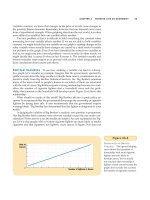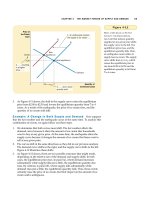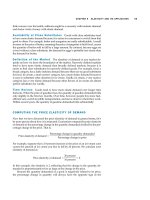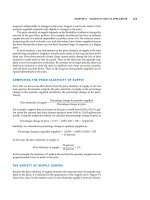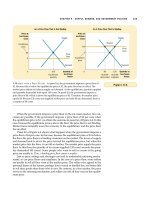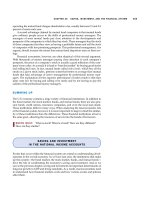Tài liệu Ten Principles of Economics - Part 58 doc
Bạn đang xem bản rút gọn của tài liệu. Xem và tải ngay bản đầy đủ của tài liệu tại đây (243.27 KB, 10 trang )
CHAPTER 26 UNEMPLOYMENT AND ITS NATURAL RATE 589
disadvantaged groups escape poverty. Advocates of these programs believe that
they make the economy operate more efficiently by keeping the labor force more
fully employed, and that they reduce the inequities inherent in a constantly chang-
ing market economy.
Critics of these programs question whether the government should get in-
volved with the process of job search. They argue that it is better to let the private
market match workers and jobs. In fact, most job search in our economy takes
place without intervention by the government. Newspaper ads, job newsletters,
college placement offices, headhunters, and word of mouth all help spread infor-
mation about job openings and job candidates. Similarly, much worker education
is done privately, either through schools or through on-the-job training. These crit-
ics contend that the government is no better—and most likely worse—at dissemi-
nating the right information to the right workers and deciding what kinds of
worker training would be most valuable. They claim that these decisions are best
made privately by workers and employers.
UNEMPLOYMENT INSURANCE
One government program that increases the amount of frictional unemployment,
without intending to do so, is unemployment insurance. This program is de-
signed to offer workers partial protection against job loss. The unemployed who
quit their jobs, were fired for cause, or just entered the labor force are not eligible.
Benefits are paid only to the unemployed who were laid off because their previous
employers no longer needed their skills. Although the terms of the program vary
over time and across states, a typical American worker covered by unemployment
insurance receives 50 percent of his or her former wages for 26 weeks.
While unemployment insurance reduces the hardship of unemployment, it
also increases the amount of unemployment. The explanation is based on one of
the Ten Principles of Economics in Chapter 1: People respond to incentives. Because
unemployment benefits stop when a worker takes a new job, the unemployed de-
vote less effort to job search and are more likely to turn down unattractive job of-
fers. In addition, because unemployment insurance makes unemployment less
onerous, workers are less likely to seek guarantees of job security when they ne-
gotiate with employers over the terms of employment.
Many studies by labor economists have examined the incentive effects of un-
employment insurance. One study examined an experiment run by the state of Illi-
nois in 1985. When unemployed workers applied to collect unemployment
insurance benefits, the state randomly selected some of them and offered each a
$500 bonus if they found new jobs within 11 weeks. This group was then com-
pared to a control group not offered the incentive. The average spell of unemploy-
ment for the group offered the bonus was 7 percent shorter than the average spell
for the control group. This experiment shows that the design of the unemployment
insurance system influences the effort that the unemployed devote to job search.
Several other studies examined search effort by following a group of workers
over time. Unemployment insurance benefits, rather than lasting forever, usually
run out after six months or a year. These studies found that when the unemployed
become ineligible for benefits, the probability of their finding a new job rises
markedly. Thus, receiving unemployment insurance benefits does reduce the
search effort of the unemployed.
unemployment insurance
a government program that partially
protects workers’ incomes when
they become unemployed
590 PART NINE THE REAL ECONOMY IN THE LONG RUN
M
ANY
E
UROPEAN COUNTRIES HAVE UN
-
employment insurance that is far more
generous than that offered to U.S.
workers, and some economists believe
that these programs explain the high
European unemployment rates. The
following article discusses the recent
debate over unemployment insurance
in Germany.
For Germany,
Benefits Are Also a Burden
B
Y
E
LIZABETH
N
EUFFER
B
ERLIN
—They grumble and grouse as
they wait for their benefit checks at a
local unemployment office here—about
the lack of jobs, about the stupidity of
German politicians, about how outra-
geously high taxes are.
What today’s unemployed Germans
don’t complain about is this: the size of
their benefit checks.
“I get unemployment benefits, I
make some money working on the black
market, I make a living,” says Michael
Steinbach, a 30-year-old electrician who
sports a well-ironed shirt, fashionable
glasses, and a briefcase as he waits his
turn at the Prenzlauer Berg unemploy-
ment office. “For now, it’s comfortable.”
Germany’s social welfare system
takes good care of the jobless, with ini-
tial average monthly checks of nearly
$900 per month for someone married—
and the prospect, for those who know
how to work the system, of remaining on
benefits for life. So blatantly do people
abuse this system that Chancellor Hel-
mut Kohl once critically described his
country as “Leisurepark Germany.” . . .
Now—partly because . . . such gen-
erous benefits are seriously straining the
nation’s economy—questions are being
raised about whether one way to combat
unemployment is to reform the social
welfare system itself. . . .
Combating unemployment, always a
hot topic here, leapt back into public de-
bate last week, after the German Labor
office released figures showing that job-
lessness inched up to 11.7 percent in
September, the fifth consecutive post-
war record. . . .
The unease here also stems from
memories of when Germany last faced
such levels of joblessness: 1933, when
the unemployed were so desperate they
begged in the streets for spare change,
relied on soup kitchens for meals, and
ushered the Nazis into power.
Postwar Germany’s reaction was to
create a massive welfare state, designed
to squelch social unrest through social
benevolence. “It’s more important to
have modestly happy people on benefits
than poverty and all its side effects such
as a high crime rate as in the United
States,” said Heiner Geissler, a leading
figure in the ruling CDU party.
It is becoming increasingly clear,
though, that preserving benefits has
trapped Germany in something of a vi-
cious circle.
The nation’s high-cost social welfare
system is one reason its labor costs are
among the highest in the world: Both
employees and employers must pay
generously into the system, so they
need higher wages and profits. More
than half of a worker’s paycheck goes to
taxes. Employer/employee-funded taxes
this year alone totaled 52.8 billion
deutsche marks, or nearly $30 billion.
But high labor costs are a major
reason companies are now fleeing for
cheaper, neighboring Poland—meaning
job losses for Germany. At the same
time, unemployment benefits have be-
come something of a velvet coffin for the
unemployed, discouraging them from
taking jobs. Until recently, workers who
worked part-time were effectively penal-
ized, as they would receive less unem-
ployment benefits if they were laid off.
And generous unemployment bene-
fits mean there is no incentive to take
part-time or low-paid work—a strategy
adopted to fight unemployment in
other countries, including the United
States. . . .
These benefits are so good that ex-
ploiting them is something of a national
sport. In a recent, and not uncommon,
conversation overheard in a Berlin cafe,
a woman bragged about how she was
using her
Sozialhilfe
to pay for a vacation
in Italy. Some Germans even register in
several districts, knowing it’s unlikely
they will be caught for receiving multiple
benefits.
Not surprisingly, more than 60 per-
cent of Germany’s unemployed are long-
term unemployed.
“People are used to, and heavily
rely on, ‘Father State,’ ” said Dieter
Hundt, president of the Confederation of
Germany Employers’ Association. “We
are a bit spoiled by a too tightly woven
social net, which doesn’t encourage the
individual enough to improve his own
situation.”
S
OURCE
: The Boston Globe, October 12, 1997, p. F1.
IN THE NEWS
German Unemployment
CHAPTER 26 UNEMPLOYMENT AND ITS NATURAL RATE 591
Even though unemployment insurance reduces search effort and raises unem-
ployment, we should not necessarily conclude that the policy is a bad one. The
program does achieve its primary goal of reducing the income uncertainty that
workers face. In addition, when workers turn down unattractive job offers, they
have the opportunity to look for jobs that better suit their tastes and skills. Some
economists have argued that unemployment insurance improves the ability of the
economy to match each worker with the most appropriate job.
The study of unemployment insurance shows that the unemployment rate is
an imperfect measure of a nation’s overall level of economic well-being. Most
economists agree that eliminating unemployment insurance would reduce the
amount of unemployment in the economy. Yet economists disagree on whether
economic well-being would be enhanced or diminished by this change in policy.
QUICK QUIZ: How would an increase in the world price of oil affect the
amount of frictional unemployment? Is this unemployment undesirable?
What public policies might affect the amount of unemployment caused by this
price change?
MINIMUM-WAGE LAWS
Having seen how frictional unemployment results from the process of matching
workers and jobs, let’s now examine how structural unemployment results when
the number of jobs is insufficient for the number of workers.
To understand structural unemployment, we begin by reviewing how un-
employment arises from minimum-wage laws—a topic we first analyzed in
Chapter 6. Although minimum wages are not the predominant reason for unem-
ployment in our economy, they have an important effect on certain groups with
particularly high unemployment rates. Moreover, the analysis of minimum wages
is a natural place to start because, as we will see, it can be used to understand some
of the other reasons for structural unemployment.
Figure 26-4 reviews the basic economics of a minimum wage. When a
minimum-wage law forces the wage to remain above the level that balances sup-
ply and demand, it raises the quantity of labor supplied and reduces the quantity
of labor demanded compared to the equilibrium level. There is a surplus of labor.
Because there are more workers willing to work than there are jobs, some workers
are unemployed.
Because we discussed minimum-wage laws extensively in Chapter 6, we will
not discuss them further here. It is, however, important to note why minimum-
wage laws are not a predominant reason for unemployment: Most workers in the
economy have wages well above the legal minimum. Minimum-wage laws are
binding most often for the least skilled and least experienced members of the labor
force, such as teenagers. It is only among these workers that minimum-wage laws
explain the existence of unemployment.
Although Figure 26-4 is drawn to show the effects of a minimum-wage law, it
also illustrates a more general lesson: If the wage is kept above the equilibrium level for
any reason, the result is unemployment. Minimum-wage laws are just one reason why
592 PART NINE THE REAL ECONOMY IN THE LONG RUN
wages may be “too high.” In the remaining two sections of this chapter, we con-
sider two other reasons why wages may be kept above the equilibrium level—
unions and efficiency wages. The basic economics of unemployment in these cases
is the same as that shown in Figure 26-4, but these explanations of unemployment
can apply to many more of the economy’s workers.
At this point, however, we should stop and notice that the structural unem-
ployment that arises from an above-equilibrium wage is, in an important sense,
different from the frictional unemployment that arises from the process of job
search. The need for job search is not due to the failure of wages to balance labor
supply and labor demand. When job search is the explanation for unemployment,
workers are searching for the jobs that best suit their tastes and skills. By contrast,
when the wage is above the equilibrium level, the quantity of labor supplied ex-
ceeds the quantity of labor demanded, and workers are unemployed because they
are waiting for jobs to open up.
QUICK QUIZ: Draw the supply curve and the demand curve for a labor
market in which the wage is fixed above the equilibrium level. Show the
quantity of labor supplied, the quantity demanded, and the amount of
unemployment.
UNIONS AND COLLECTIVE BARGAINING
A union is a worker association that bargains with employers over wages and
working conditions. Whereas only 16 percent of U.S. workers now belong to
W
E
Quantity of
Labor
L
E
0
Surplus of labor
ϭ
Unemployment
Labor
supply
Labor
demand
Wage
Minimum
wage
L
D
L
S
Figure 26-4
U
NEMPLOYMENT FROM A
W
AGE ABOVE THE
E
QUILIBRIUM
L
EVEL
. In this labor market,
the wage at which supply and
demand balance is W
E
. At this
equilibrium wage, the quantity of
labor supplied and the quantity
of labor demanded both equal L
E
.
By contrast, if the wage is forced
to remain above the equilibrium
level, perhaps because of a
minimum-wage law, the quantity
of labor supplied rises to L
S
, and
the quantity of labor demanded
falls to L
D
. The resulting surplus
of labor, L
S
–L
D
, represents
unemployment.
union
a worker association that bargains
with employers over wages and
working conditions
CHAPTER 26 UNEMPLOYMENT AND ITS NATURAL RATE 593
unions, unions played a much larger role in the U.S. labor market in the past. In
the 1940s and 1950s, when unions were at their peak, about a third of the U.S. labor
force was unionized. Moreover, unions continue to play a large role in many
European countries. In Sweden and Denmark, for instance, more than three-
fourths of workers belong to unions.
THE ECONOMICS OF UNIONS
A union is a type of cartel. Like any cartel, a union is a group of sellers acting to-
gether in the hope of exerting their joint market power. Most workers in the U.S.
economy discuss their wages, benefits, and working conditions with their em-
ployers as individuals. By contrast, workers in a union do so as a group. The
process by which unions and firms agree on the terms of employment is called col-
lective bargaining.
When a union bargains with a firm, it asks for higher wages, better benefits,
and better working conditions than the firm would offer in the absence of a union.
If the union and the firm do not reach agreement, the union can organize a with-
drawal of labor from the firm, called a strike. Because a strike reduces production,
sales, and profit, a firm facing a strike threat is likely to agree to pay higher wages
than it otherwise would. Economists who study the effects of unions typically find
that union workers earn about 10 to 20 percent more than similar workers who do
not belong to unions.
When a union raises the wage above the equilibrium level, it raises the quan-
tity of labor supplied and reduces the quantity of labor demanded, resulting in un-
employment. Those workers who remain employed are better off, but those who
were previously employed and are now unemployed at the higher wage are worse
off. Indeed, unions are often thought to cause conflict between different groups of
workers—between the insiders who benefit from high union wages and the out-
siders who do not get the union jobs.
The outsiders can respond to their status in one of two ways. Some of them
remain unemployed and wait for the chance to become insiders and earn the high
union wage. Others take jobs in firms that are not unionized. Thus, when unions
raise wages in one part of the economy, the supply of labor increases in other parts
of the economy. This increase in labor supply, in turn, reduces wages in industries
that are not unionized. In other words, workers in unions reap the benefit of col-
lective bargaining, while workers not in unions bear some of the cost.
The role of unions in the economy depends in part on the laws that govern
union organization and collective bargaining. Normally, explicit agreements
among members of a cartel are illegal. If firms that sell a common product were to
agree to set a high price for that product, the agreement would be a “conspiracy in
restraint of trade.” The government would prosecute these firms in civil and crim-
inal court for violating the antitrust laws. By contrast, unions are exempt from
these laws. The policymakers who wrote the antitrust laws believed that workers
needed greater market power as they bargained with employers. Indeed, various
laws are designed to encourage the formation of unions. In particular, the Wagner
Act of 1935 prevents employers from interfering when workers try to organize
unions and requires employers to bargain with unions in good faith. The National
Labor Relations Board (NLRB) is the government agency that enforces workers’
right to unionize.
collective bargaining
the process by which unions
and firms agree on the
terms of employment
strike
the organized withdrawal of
labor from a firm by a union
